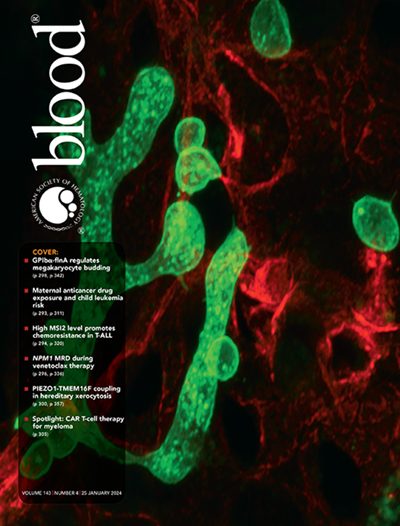Multiomics analysis reveals the genetic and epigenetic features of high-risk NK cell-type chronic active EBV infection.
IF 23.1
1区 医学
Q1 HEMATOLOGY
引用次数: 0
Abstract
Chronic active Epstein-Barr virus (EBV) infection (CAEBV) is an orphan disease characterized by the proliferation and infiltration of EBV-infected T/natural killer (NK) cells into multiple organs. Although CAEBV is a heterogeneous disease with diverse clinical courses, its pathogenesis remains poorly understood. In this study, we explored the molecular mechanisms underlying CAEBV by performing a comprehensive multi-omics analysis, including genome, transcriptome, epigenome, and single-cell transcriptome and surface proteome analyses, of 65 CAEBV patients. Methylation analysis identified two distinct subtypes of NK cell-type CAEBV based on the CpG island methylator phenotype (CIMP). In CIMP-positive CAEBV, regions associated with enhancer of zeste homolog 2 binding sites and histone H3 lysine 27 trimethylation exhibited increased DNA hypermethylation, resulting in downregulation of tumor suppressor and anti-herpes virus genes. CIMP-positive CAEBV had a particularly poor prognosis and displayed a "neoplastic" phenotype with a DNA methylation pattern similar to that of extranodal NK/T-cell lymphoma, a higher tumor mutation burden, and frequent copy number alterations. In addition, both in vitro and in vivo functional assays demonstrated that 5-Azacytidine, a hypomethylating agent, was a potentially effective agent for high-risk CIMP-positive CAEBV. Finally, we established a method to effectively detect EBV-infected cells in single-cell analysis, suggesting that EBV-infected NK cells have tissue-resident properties and that innate and adaptive immunity to EBV is compromised in patients with CAEBV. The present findings provide insight into the complex molecular features of CAEBV and suggest potential molecular therapies.多组学分析揭示了高危NK细胞型慢性活动性EBV感染的遗传和表观遗传特征。
慢性活动性eb病毒(EBV)感染(CAEBV)是一种以EBV感染的T/自然杀伤(NK)细胞增殖和浸润到多器官为特征的孤儿病。尽管CAEBV是一种具有不同临床病程的异质性疾病,但其发病机制仍知之甚少。在这项研究中,我们通过对65例CAEBV患者进行全面的多组学分析,包括基因组、转录组、表观基因组、单细胞转录组和表面蛋白质组分析,探索了CAEBV的分子机制。基于CpG岛甲基化表型(CIMP),甲基化分析鉴定出NK细胞型CAEBV的两种不同亚型。在cimp阳性CAEBV中,与zeste同源物2结合位点增强子和组蛋白H3赖氨酸27三甲基化相关的区域显示出DNA高甲基化增加,导致肿瘤抑制和抗疱疹病毒基因下调。cimp阳性CAEBV预后特别差,表现为“肿瘤性”表型,DNA甲基化模式与结外NK/ t细胞淋巴瘤相似,肿瘤突变负担更高,拷贝数频繁改变。此外,体外和体内功能分析表明,5-氮杂胞苷(5-Azacytidine)是一种低甲基化剂,可能是治疗高危cimp阳性CAEBV的有效药物。最后,我们建立了一种在单细胞分析中有效检测EBV感染细胞的方法,这表明EBV感染的NK细胞具有组织驻留特性,并且CAEBV患者对EBV的先天和适应性免疫受到损害。目前的研究结果提供了对CAEBV复杂分子特征的深入了解,并提出了潜在的分子治疗方法。
本文章由计算机程序翻译,如有差异,请以英文原文为准。
求助全文
约1分钟内获得全文
求助全文
来源期刊

Blood
医学-血液学
CiteScore
23.60
自引率
3.90%
发文量
955
审稿时长
1 months
期刊介绍:
Blood, the official journal of the American Society of Hematology, published online and in print, provides an international forum for the publication of original articles describing basic laboratory, translational, and clinical investigations in hematology. Primary research articles will be published under the following scientific categories: Clinical Trials and Observations; Gene Therapy; Hematopoiesis and Stem Cells; Immunobiology and Immunotherapy scope; Myeloid Neoplasia; Lymphoid Neoplasia; Phagocytes, Granulocytes and Myelopoiesis; Platelets and Thrombopoiesis; Red Cells, Iron and Erythropoiesis; Thrombosis and Hemostasis; Transfusion Medicine; Transplantation; and Vascular Biology. Papers can be listed under more than one category as appropriate.
 求助内容:
求助内容: 应助结果提醒方式:
应助结果提醒方式:


